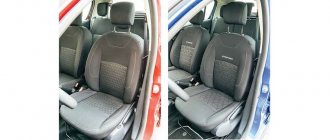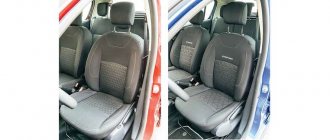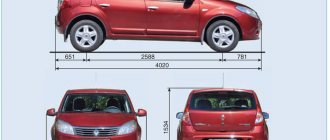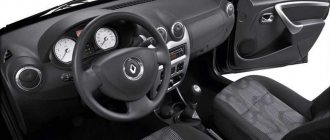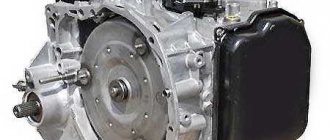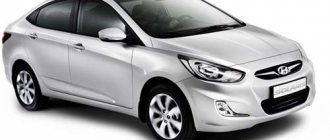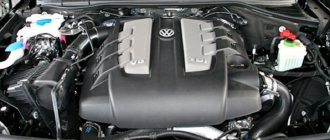Definition
Sandero is a class B car and has a hatchback body. It is built on the Logan platform, but differs from it. It has an expressive silhouette, smooth flowing lines, and beautiful optics. Sandero is a very practical car, perfect for a large family.
Renault Sandero
Stepway resembles a crossover in all respects. He has a stylish and recognizable appearance. It is, in fact, an all-terrain version of the Sandero hatchback. Stepway now has additional body kits and increased ground clearance. This is an excellent option for urban conditions: the car is not afraid of high curbs, it can easily move along snowy and icy streets.
Renault Sandero Stepway
Test drive Renault Sandero Stepway: old versus new
Stepway is without a doubt a success for Renault marketers. At minimal cost, the French managed to create an almost different model in the eyes of buyers - a kind of ultra-budget “mini-jeep”. Now, five years later, the second generation of the model has appeared on the previous basis. It looks definitely better and more elegant, but also, of course, more expensive. So is it worth changing, and is the difference really that significant? We put everything into perspective together with the owners of the previous generation.
Appearance
The most obvious and, for most Stepway buyers, almost the decisive argument. Whatever one may say, the first Sandero, roughly drawn and as if hewn around the edges with an ax and chisel, quickly betrayed its budget origins. The appearance of the Stepway version instantly expanded the model's target audience. Increased ground clearance, silver-black plastic, diffusers on the bumpers and roof rails - the Sandero Stepway has turned into a kind of good branded sneaker for every day, which you may not show off to your neighbors, but you will wear regularly and, most importantly, with pleasure.
Having kicked out the “carpenters” and thrown away the axes, Renault management finally invited designers, setting the primary task of washing away the budget taint from the new generation of the entire Logan line. What can I say, the task was completed with five points, and the new Stepway is a clear confirmation of this.
The car has changed radically, while remaining in a completely recognizable style. Design elements appeared on the body, the look frowned, the bumpers became massive, the arches widened, and the color scheme acquired bright, attractive colors. Plus, the new Stepway, almost unchanged in width and length, has grown by a considerable 68 mm, which visually brings it even closer to crossovers.
There is reason to believe that the third generation of the model may finally get all-wheel drive, finally saying goodbye to the title of an ordinary raised hatchback. At least, this can be indirectly judged by the statements of Oleg Grunenkov, the director of the AvtoVAZ Lada X- RAY project, who in an interview with our magazine stated that the implementation of the 4x4 version for the X- RAY is underway. Let us remind you that it is Sandero Stepway that is the production donor for the new domestic crossover.
Renault specialists also worked on pragmatic improvements. First of all, over the ground clearance, which has been increased by another 20, and in total by 40 mm, and is almost off-road 195 mm. In addition, 16-inch wheels are now standard, not 15, and not on soft cast wheels, but on more durable stamped wheels. True, now you will have to spend more on tires. The thresholds lost their silver molding - the owners complained that they were easily scratched.
Don't believe your eyes! The striking wheels with five wide spokes are actually advanced “stamping” with hubcaps placed on top. I remember that Opel started dabbling in similar disguises . You can pay an additional 18,000 rubles for real ones, but we don’t see much point in this.
Interior
When testing new models, changes that have occurred in comparison with the predecessor usually have to be compared from memory, in which several of the most obvious and visible differences remain. They improved it here, changed it here, added something here. When both Sandero Stepways were side by side, it became clear that the difference in the interior was simply colossal.
The interior of a first-generation car, unless of course you compare it with a Zhiguli, practically elevates the word “budget” to the absolute level. Its main advantage is relative space in all directions. But otherwise...
Among the design delights and “sybaritic” options, one can only note the “boomerang” handles on the front doors and the leather trim of the steering wheel. But they didn’t skimp on cheap plastic. Even to the touch you can feel that the thickness and rigidity of the solid panels is such that by removing them, you can protect yourself from enemies if you wish. On the other hand, the massiveness of the finish affected its strength - in 1.5 years and almost 20,000 km, nothing in the interior came off or broke off. In short, there are complaints about the assembly and casting of small parts. Small plastic covers and plugs with burrs everywhere. Their joining is not smooth everywhere, and there are gaps between the individual elements.
The main problem with the interiors of the entire first-generation Logan family is a whole bunch of ergonomic flaws, which only the lazy didn’t talk about back then. Owners slowly got used to looking for power windows on the front panel, adjusting mirrors under the handbrake, and heated seats in the gap between the doors. Reaching and tripping over the gearbox lever, switching the heater, and turning on the windshield washer separately from the wipers.
The seats of the first Sandero Stepway are another attribute of criticism. With a minimal set of adjustments, a dip in the lumbar area and a push-out zone in the shoulder blade area. People above average height find these uncomfortable, to put it mildly. The flat and rigid rear row has a good amount of space in width and height, and sufficient space in the legs.
Over time, you get used to all the interior features of the first Sandero Stepway. In addition, the car has the minimum necessary set of all amenities, including air conditioning. And the most important thing is that with age, none of this fails, continuing to perform all its functions.
Transfer to the blue Stepway and you get the full feeling that the creators of the new generation wrote down all the complaints about the old one point by point. Despite the fact that the plastic has not become softer, everything in the cabin has changed. The front panel, cast in smooth waves, is decorated with black gloss and chrome trim. Moreover, joining dissimilar panels and casting small parts no longer raises any questions.
Before your eyes is a Megan instrument panel with an on-board computer screen, a heated “mesh” on the windshield, and cruise control buttons on the steering wheel, molded to the correct grip. The temperature in the cabin is controlled by a full-fledged “climate” raised above the gearshift lever. And all the keys and adjustments have moved to their proper places. All this is crowned by an inexpensive, but full-fledged and intelligent multimedia system with navigation, a USB port, Bluetooth support and, what is especially pleasing, is a simple and intuitive interface. The level of equipment for a “state employee” is beyond praise!
Seats? The upholstery materials have noticeably improved. There is no increase in lateral support, there is a “hole” in the lower back, but the upper edges no longer dig into the shoulder blades. A microlift appeared, but the heating button remained in the same inconvenient place. But the rear sofa has hardly changed - it’s also hard, but also roomy.
The trunk volume has not changed at all – it remains the same as it was, 320 liters. This is quite enough for all urban needs. It’s a pity that there are no compartments or pockets for small items; in addition, the luggage rack is poorly secured. If necessary, the rear seats can be folded in sections. The spare wheel is fixed under the bottom - the solution has both pros and cons.
Technology and driving features
But structurally, since 2009, and by and large since 2004, almost nothing has changed in the cars. Although, if you look more closely... The platform is still the same - Logan’s B0. The suspension is standard: independent MacPherson strut at the front, semi-independent beam at the rear. But the chassis characteristics were slightly adjusted, increasing the stiffness of the shock absorbers and strengthening the transverse stabilizer.
The engine is also one for two – the well-known 1.6-liter 16-valve naturally aspirated gasoline engine of the K4M series with a power of 102 horsepower. The only difference is that the first generation car allows the use of “92” gasoline, but in the new modification, which has received the fifth class of environmental friendliness, no lower than “95” is allowed.
We got different gearboxes. A four-speed automatic transmission on the first generation is a mandatory requirement of the owner’s wife. The new Stepway is still content with a non-alternative five-speed manual transmission - the same as on the previous Renault.
Let’s say in advance that the lack of an “automatic” was the main reason for the refusal of the owners of the brown Stepway to exchange their current car for a new one. In addition, we have already compared the new Sandero Stepway with one of its competitors, which also offers a “two-pedal” version. As if anticipating the conclusions, Renault, at the time of writing this material, announced the entry into the Russian market of new modifications of Logan, Sandero and Sandero Stepway, not only with automatic, but also with a new robotic transmission. Additional payment - from 20,000 to 38,000 rubles.
Regardless of the transmission, driving a new hatchback is more convenient and comfortable. Changing from one car to another, it became clear that the first generation Sandero Stepway, in addition to the specific features of sitting with a high seat, also has a strong inclination of the damped pedals, due to which the feet have to be extended when pressed. In the new one, installation of pedals and their calibration are noticeably more convenient, although travel and sensitivity are also not ideal.
The dynamics of the cars are not very different and fully correspond to the installed transmissions. The “old” Stepway with an automatic transmission accelerates quite confidently, but smoothly, without zealous acceleration. You can’t ask for much from a box with four “long” stages, but if you don’t perceive the car as a sports car, there are quite enough possibilities. Unless you have to overtake on the highway with a good margin.
The new manual Stepway is not so much more dynamic as it is more predictable - it is more convenient to manually control the engine thrust, which is concentrated in the mid-speed zone. Put it in gear so that the tachometer needle falls into the 2500-3000 rpm zone - you get a good pickup and a slow but distinct jerk forward.
The acute sensitivity of the “first” Stepway to small irregularities was a revelation - it shakes noticeably more than in the new one. Perhaps after 20,000 km the shock absorbers have already worn out. With an equally impenetrable suspension that bravely withstands both curved country roads and speed bumps, the blue car flew over potholes more smoothly, not noticing the small ones at all. But it’s not easy to call Stepways truly comfortable, also because of the average “noise.”
But in terms of handling, in general, nothing has changed, except that the steering wheel itself in the new car has become more comfortable to grip. At low speeds, both Sandero Stepways have to turn the steering wheel with effort. But there is a feeling of control over the car, although the control cannot be called informative due to some rubberiness either - it is rather predictably stable. Both on straight asphalt and in corners, the cars handle well, giving no reason for fear or sudden steering.
What's the result?
I remember when the first Stepway was tested for a long time several years ago, I recommended this car only to those who spend more time outside the city, are ready for certain hardships, are ready to put up with it, are ready to get used to it. With a lot. The car proved to be strong, reliable, but very ascetic and specific. Now I can say that if your eye has fallen on the new Sandero Stepway, feel free to brush aside all thoughts and go to the car dealership. For this money you simply cannot find a more versatile machine. And what kind of money, you ask?
The Renault Sandero Stepway with an automatic transmission that took part in the test was purchased at the beginning of 2014 for 570,000 rubles, excluding additional equipment and delivery. The current one with “mechanics” is already estimated at 678,000 rubles. “Automatic” will add another 38,000 rubles. Total – 716,000 rubles or 146,000 rubles difference.
Taking into account the depreciation of the old car, the surcharge is considerable. However, if you look at it, there are almost a hundred options added to the new generation alone. And also technical and quality improvements, the collapse of the ruble exchange rate and almost 20% inflation. All this is already included in the new price. So, it turns out to be an absolutely reasonable increase for an extremely talented car. In addition, it is not at all necessary to choose the top version - prices for a modern Stepway even now start at 577,000 rubles.
Well, as for the owners of the brown hatchback, they are completely satisfied with their Stepway. Yes, I had to get used to some things, but the number of functions performed, and most importantly, reliability, multiplied by the low price of both the machine itself and its maintenance, cover the shortcomings.
Despite the fact that they really liked the new Stepway, they are not going to change their car. There are three reasons, says Ilya: “Firstly, with almost constant use of the car in a metropolis, the manual version is not considered. Secondly, the existing machine has not yet reached its intended service life - we bought it a little over a year ago, so it is simply not profitable to replace it. And thirdly, the economic situation in the country is somehow still causing concern. So let's wait and see. Definitely the new Stepway will be at the top of your list of choices.”
The editors of the “Engine” magazine express gratitude to the Russian representative office of Renault, as well as Ilya and Olga Nikolsky for providing the car and assistance in preparing the material.
Comparison
Sandero Stepway and Sandero visually look different. Sandero looks more like a nice family hatchback, while Stepway looks like an agile and dynamic crossover, and it’s more youthful. The front mudguards immediately catch your eye: on the Stepway they are smaller than on the Sandero, made of plastic and attached differently.
There is a difference between the cars in ground clearance, which is especially noticeable. Stepway's is 20 mm larger. This was achieved by adding half a turn of the spring and making changes to the mounting location of the strut. The gap between the wheel and the wheel well cutout has increased. There are also differences in details, albeit minor ones.
The Stepway uses trailing arm suspension that is connected to a beam mounted to the body. An anti-roll bar was also added to the coil spring and shock absorber struts. And another innovation in Stepway is the eighth generation Bosch ABS system. There is electronic brake force distribution EBD, as well as an EBA brake booster. All this is missing in Sandero.
Stepway also features exclusive interior trim, darkened tinted headlights, chrome-painted mirrors, a chrome trim on the exhaust pipe, and even a leather-wrapped steering wheel is possible.
In modern conditions, it is difficult to impress an experienced car enthusiast when buying a car. This is not surprising, since today the market offers machines for every taste and a variety of configurations. The article contains an analysis and a small comparison of the advantages and disadvantages of two representatives of the French automobile industry Renault: Duster and Sandero Stepway. Based on the results, the winner will be determined. Let's try to understand which is better.
Few technical differences
Even though the standard model is not very different from the new one, there are still differences.
- High ground clearance of 195 millimeters versus 175 millimeters, respectively.
- The gearbox shifter is driven by a cable.
- Squeezing the clutch using a hydraulic drive versus a cable drive.
- Luggage rails on the roof of a car.
- On later versions of the Stepway, the right wheel drive received a one-piece design. On the old model it had an intermediate bearing.
- Chrome trim on the front and rear bumper.
- Chrome plated muffler tip.
- Aggressive door sills.
- Changed fabric upholstery with Stepway logo.
- Possibility of installing larger diameter discs for the new model.
There are many other subtle differences, such as the ABS system and anti-roll bar. In addition, the new crossover has powerful mudguards, which has a very good effect in the harsh weather conditions of Russian winters. This car has become more youthful, thanks to increased ground clearance and new powerful bumpers and side linings.
A huge number of photos posted on the Internet will not convey to you the admiration and pleasure from this car that every car owner experiences.
All these changes undoubtedly give the new car more advantages over its competitors, and the appearance of the new crossover is much nicer than a standard hatchback.
What does Sandero look like from the outside?
In the comparative characteristics of Duster versus Renault Sandero Stepway, the exterior plays a significant role. However, the reader may have a question: why is it necessary to compare two cars that were produced within the walls of the same automaker and implemented identical design solutions regarding the appearance.
But this is not entirely true, so it is advisable to compare the Renault Duster and Renault Sandero Stepway cars. First, about the general features. Renault Duster is a classic all-terrain vehicle. This is supported by the high bevel of the bumper, the presence of plastic inserts above the wheel arches and the threshold on both sides of the car. The minimum clearance from the road to the car is quite respectable and amounts to 200 mm, which confirms the idea of the Duster as a 100% SUV. You need to compare all this to understand which is better.
Main Differences
In our opinion, Renault Sandero Stepway has a number of small differences from Renault Sandero, which are not immediately noticeable to the average person. The suspension height in both cases is definitely pleasing; both hatchbacks are adapted to both heavy traffic in the city and measured driving on the highway.
Ultimately, in order to compare Renault Sandero and Renault Sandero Stepway, you need to contact an official Renault dealer in your city.
At the company’s office, they will certainly be able to tell you about the features of each of the models with a certain modification, and you can also go for a test drive in any of the cars you choose.
A test drive will definitely tell you what the differences are between the models and which one is more suitable for you.
Interior decoration
The presence of a general concept for interior design in a confrontation, when comparing Renault Duster against Renault Sandero Stepway, does not allow us to identify a winner in this parameter. First, about the dashboard, the location of the instruments. Both brands follow the common traditions of the French manufacturer, which can usually be seen on the Logan line: the panel shield is very bright, but at the same time remains quite comfortable for the driver. Therefore, Renault developers could not come up with anything better for the new model range.
The console, located in the center, has some distinctive features. In the comparison between Duster and Renault Sandero Stepway, the former lags slightly behind: the placement of the basic multimedia system requires the driver’s attention to be regularly taken away from the road situation, while the competitor does not have this unpleasant moment due to the better location of the monitor.
According to other characteristics, both Frenchmen received as a gift from the designers a comfortable and ergonomically correct interior, which simply cannot be found more ideal for crossovers.
Fishing is better with mechanics
Sandero Stepway assumes some off-road capability. But the variator nullifies it. You can’t crawl with it in the mud on the way to fishing, as this puts too much stress on the metal belt and on the pulleys of the continuously variable transmission. The variator will quickly overheat and generate a transmission error. However, the geometric cross-country ability of the car is excellent. Climbing onto a curb or over a drainage ditch is a breeze with the Sandero Stepway.
Article on the topic
Let's do without dirt. Does Renault Duster need all-wheel drive? And even on bad roads this car gives incredible pleasure. No matter what hole there is on the road, the Sandero is not afraid of it. It’s easier to bend a threshold or break a bumper from an unsuccessful jump than to damage wheels with impenetrable long-travel suspension.
In general, the Sandero Stepway does not like to drive fast, even with a CVT. A comfortable speed for him is 110 km/h. The CVT feels best at this speed and achieves maximum efficiency. The pulleys move to their extreme positions, the engine speed drops to 2500, and the car shows consumption of 8.5 liters of 95 gasoline. And this is about 0.5 liters less than with a 4-speed automatic. This is exactly the average consumption we had on the meter after the circle Moscow - Kalyazin - Yaroslavl - Moscow.
The main thing is not to stomp on the accelerator, accelerate smoothly, and in about half an hour the adaptive automatic transmission will learn to be economical.
Technical component
In this regard, the Duster is more impressive when compared to its competitor. This is due to a number of issues. Firstly, this SUV, at the customer’s discretion, can be equipped with both a gasoline internal combustion engine and a diesel engine, which is not typical for Stepway. You can choose a car configuration with a turbocharged diesel power plant, which creates a power of 90 “horses” with an appetite of 5.5 l/100 km.
On gasoline analogues, the power will be more impressive than 102 hp. and 135 hp at a cost of about 10 l/100 km. Sandero Stepway can be equipped with only two engine options with a volume of 1.6 liters each. While the first can boast a power of only 84 horsepower, the other produces an identical power indicator as that of its rival competitor and is 102 hp.
On Renault Duster, all four wheels are driven. In this case, all-wheel drive can be engaged either manually or automatically. This will give the car high cross-country ability. Renault Sandero Stepway cannot claim such indicators: installing the drive on only one pair of wheels makes the car only a “city dweller”.
Transmission
A version with automatic transmission appeared in the summer of 2011. Until that time, only a 5-speed manual transmission was offered, which was paired exclusively with the 8-valve 1.6.
The manual transmission was different from the one installed in a regular hatchback. The Stepway used a JR5 gearbox, and the Sandero used a JH3. In addition to other gear ratios, the raised version used a hydraulic clutch drive and a cable gear selection mechanism.
The drive shafts are also different. There is no vulnerable left drive seal boot, which often leaked. This means you won't have to worry about transmission fluid leaks (at least for now).
A manual transmission clutch usually lasts more than 100-150 thousand km (from 5,000 rubles per set).
The 4-speed automatic DP2 was relied upon only by the most powerful 16-valve 1.6. The gearbox shifts are almost imperceptible, and it is tuned for a sedate ride. An automatic transmission is not suitable for traffic light racing or dynamic overtaking. Fortunately, there are no serious problems with it.
What to choose?
As for modular platforms, in this regard the cars are absolutely identical. However, in the design of the Sandero Stepway you can see black and silver plastic linings, which are absent on the regular Sandero. In addition, you can notice differences in the interior of the Stepway, which are expressed in the authentic style of the design of the dashboard elements, and in the quality of finishing work. Most likely, the developers took this step to immediately indicate that the driver is driving a modified version of the car.
Differences
If you believe the official data, the ground clearance is significantly higher for the Sandero Stepway - 195 mm/155 mm. This difference was achieved by installing different springs. However, as real car owners note, in fact the ground clearance is even higher - 195 mm/160 mm, respectively. This is a rare case when a car exceeds all expectations.
When loaded, the cars sag noticeably: 175 mm/135 mm, but this does not in any way affect the dynamics indicators, and the models still remain very playful. And doesn’t the ground clearance for an overloaded ground clearance of 175 mm look impressive? This is fantastic, and few people can do anything against it.
As for the suspension, the cars are equipped with very similar systems. There are only slight differences in geometry and some cross-country ability, but they are not significant. Also, the gearboxes of both cars boast the same gear ratios. And the gearboxes are generally similar, only the regular Sandero is driven by traction, while the Stepway is driven by a cable. Of course, this does not in any way affect the driving performance of the models, so there is no point in focusing on this point. The disadvantage of Sandero and Stepway transmissions is their not very accurate and clear shifting.
The threat of authorities
The experts decided to conduct another interesting experiment - to contrast the front-wheel drive Sandero Stepway with the all-wheel drive Nissan Terrano. In order to somehow equalize the forces, the wheels of the French car were wrapped with special chains. So, for the first 200-300 m of the race the cars were level, but then Nissan took the lead and was 4 lengths ahead of its opponent. All things considered, this is a very good result and Renault deserves compliments.
Some experts have noted that if bracelets were used instead of chains, Stepway would be able to better realize its potential. Be that as it may, it is up to each owner of this model to test or not test this hypothesis. It is only important to remember that with bracelets or chains it is better not to accelerate more than 50 km/h.
